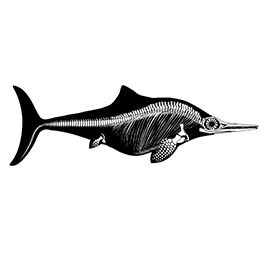OPHTHALMOSAURIDS (ICHTHYOSAURIA: THUNNOSAURIA): ALPHA TAXONOMY, CLADES AND NAMES
DOI:
https://doi.org/10.5710/PEAPA.25.09.2015.96Abstract
Abstract. Thunnosaurian ichthyosaurs represent the paradigm of reptilian body designed for a pelagic life style. Most derived thunnosaurian, the ophthalmosaurids, have been traditionally considered as members of a declining lineage. New findings and the re-examination of historical collections radically changed our conceptions about them. Opthalmosaurids were ecologically more diverse than previously thought. The past few decades have seen an increase of nominal species spurred by new findings and analyses. A still unresolved problem is that many species are only known by their holotypes. Nevertheless, morphological disparity is a compelling argument for considering them as valid. All recent cladistic analyses of ichthyosaurs recover ophthalmosaurids as a clade. Neither the addition of new information nor the addition of new entities resulted in its collapse. On this basis, the assignment of Linnaean rank to this clade (Ophthalmosauridea) is reasonable as it satisfied the primary recommended criteria for taxa naming: monophyly and stability. As the lists of species and genus names are used as input in major data bases for interpreting major turnover and/or extinction patterns, efforts must be focused on clarifying as much as possible the alpha taxonomy. Two major pending issues are the delimitation of Ophthalmosaurus-Baptanodon, and Platypterygius. The case of Platypterygius is complex because the type species is poorly known, its holotype is lost, and there is no consensus among specialist about the species that should be included in this genus. On the other hand, we advocate for the use of the name Baptanodon natans instead of Ophthalmosaurus natans.
KEY WORDS. Ophthalmosaurids. Nominal species. Species delimitations.
Resumen. OFTALMOSÁURIDOS (ICHTHYOSAURIA: THUNNOSAURIA): TAXONOMÍA ALFA, CLADOS Y NOMBRES. Los ictiosaurios tunosaurios representan, entre los reptiles, el paradigma de la adaptación secundaria a la vida pelágica. Los tunosaurios más derivados, los oftalmosáuridos, han sido considerados tradicionalmente como miembros de un linaje en declive. Nuevos hallazgos, y la revisión de las colecciones históricas, cambiaron radicalmente nuestras concepciones acerca de ellos indicando que eran ecológicamente muy diversos. En las últimas décadas se ha producido un aumento de las especies nominales de oftalmosáuridos. Un problema aún no resuelto es que muchas especies sólo son conocidas por sus holotipos. No obstante, la disparidad morfológica es un argumento de peso para considerarlas como válidas. Todos los análisis cladísticos recuperan a los oftalmosáuridos como un grupo monofilético. La adición de nueva información no provoca su colapso. Sobre esta base la asignación de rango linneano a este clado (Ophthalmosauridea) es razonable ya que cumple con los criterios recomendados para nombrar taxones: monofilia y estabilidad. Dado que las listas de especies y géneros se utilizan frecuentemente como datos básicos para interpretar patrones faunísticos y de extinción, los esfuerzos deben centrarse en aclarar lo más posible las listas taxonómicas. Dos temas pendientes son la delimitación de Ophthalmosaurus-Baptanodon y de Platypterygius. El caso de Platypterygius es complejo debido a que la especie tipo es poco conocida, su holotipo está perdido, y no hay consenso entre los especialistas sobre las especies que deben ser incluidas en él. Por otra parte, proponemos mantener el uso del nombre Baptanodon natans en lugar de Ophthalmosaurus natans.
PALABRAS CLAVES. Oftalmosáuridos. Especies nominales. Delimitación de especies.

Downloads
Published
Issue
Section
License
Copyright (c) 2015 Publicación Electrónica de la Asociación Paleontológica Argentina

This work is licensed under a Creative Commons Attribution-NoDerivatives 4.0 International License.
Authors retain copyright and grant the journal right of first publication with the work simultaneously licensed under a Atribución/Reconocimiento 4.0 Internacional that allows others to share the work with an acknowledgement of the work's authorship and initial publication in this journal.















